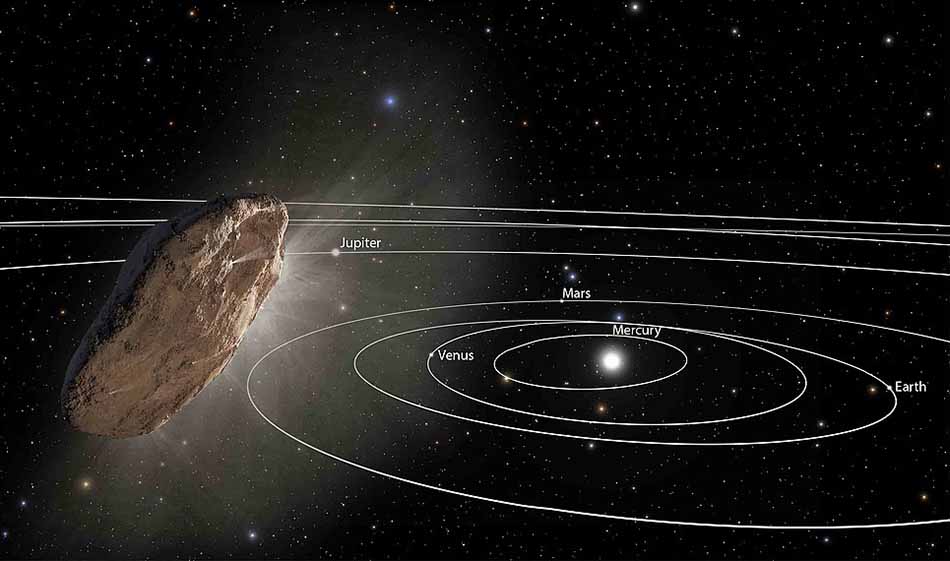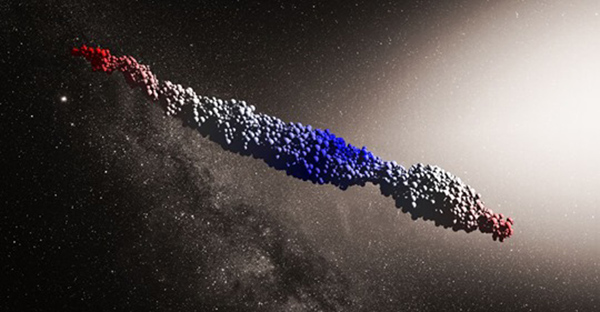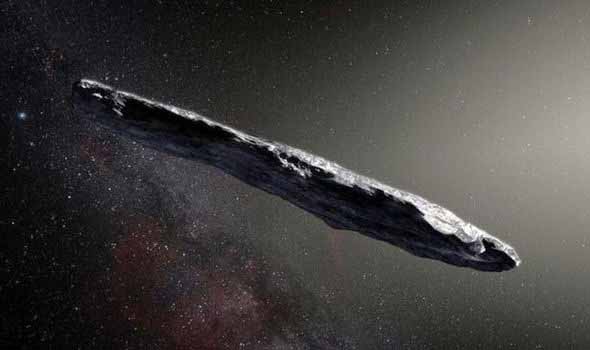

This is not a UFO but stretches the imagination so one can believe. No entities. Check it out. If anything it's a probe.
-
'Oumuamua is the first interstellar object detected passing through the Solar System. It is a small stellar object that some think could be a UFO or solar sail send to explore outer space.
Formally designated 1I/2017 U1, it was discovered by Robert Weryk using the Pan-STARRS telescope at Haleakala Observatory, Hawaii, on 19 October 2017, 40 days after it passed its closest point to the Sun. When first seen, it was about 33,000,000 km (21,000,000 mi; 0.22 AU) from Earth (about 85 times as far away as the Moon), and already heading away from the Sun.
It has a dark red color, similar to objects in the outer Solar System. 'Oumuamua showed no signs of a comet tail despite its close approach to the Sun, but has since undergone non-gravitational acceleration consistent with comet outgassing. It has significant elongation and rotation rate, so it is thought to be metal-rich with a relatively high density.
'Oumuamua is tumbling, rather than smoothly rotating, and is moving so fast relative to the Sun that there is no chance it originated in the Solar System. It also means that 'Oumuamua cannot be captured into a solar orbit, so it will eventually leave the Solar System and resume traveling through interstellar space.'Oumuamua's system of origin and the amount of time it has spent traveling amongst the stars are unknown.
In September 2018, astronomers described several possible home star systems from which 'Oumuamua may have begun its interstellar journey. However, the object did not pass particularly close to any of those objects, making its origin from any one of them improbable. Read more
Strange Acceleration of Mysterious Interstellar Visitor Finally Explained Science Alert - March 22, 2023
An interstellar object that is currently on its long journey back out of our Solar System has a completely natural explanation, in spite of its odd quirks. The peculiar acceleration of 'Oumuamua, new research confirms, can be fully attributed to the release of molecular hydrogen gas. 'Oumuamua first appeared on our horizons in October 2017, a mere month after it made its closest pass to the Sun, looping around and speeding back out of the Solar System on its continuing journey through the cosmos. We hadn't then - and we haven't since - seen anything like it in our home system, and it's still deeply interesting to astronomers.
Scientists determine the origin of extra-solar object 'Oumuamua PhysOrg - March 17, 2021
In 2017, the first interstellar object from beyond our solar system was discovered via the Pan-STARRS astronomical observatory in Hawaii. It was named 'Oumuamua, meaning "scout" or "messenger" in Hawaiian. The object was like a comet, but with features that were just odd enough to defy classification. Scientists determine the origin of extra-solar object 'Oumuamua.
Interstellar visitor 'Oumuamua could still be alien technology, new study hints Live Science - August 19, 2020
'Oumuamua - a mysterious, interstellar object that crashed through our solar system two years ago - might in fact be alien technology. ThatŐs because an alternative, non-alien explanation might be fatally flawed, as a new study argues. But most scientists think the idea that we spotted alien technology in our solar system is a long shot. In 2018, our solar system ran into an object lost in interstellar space. The object, dubbed 'Oumuamua, seemed to be long and thin - cigar-shaped - and tumbling end over end. Then, close observations showed it was accelerating, as if something were pushing on it. Scientists still aren't sure why. One explanation? The object was propelled by an alien machine, such as a lightsail - a wide, millimeter-thin machine that accelerates as it's pushed by solar radiation. The main proponent of this argument was Avi Loeb, a Harvard University astrophysicist.
Scientists determine the interstellar object 'Oumuamua isn't made from molecular hydrogen ice after all PhysOrg - August 18, 2020
Traveling at a blistering speed of 196,000mph in 2017, 'Oumuamua was first classified as an asteroid, and when it later sped up, was found to have properties more akin to comets. But the 0.2km radius interstellar object didn't fit that category, either, and its point of origin has remained a mystery. Researchers focused on the giant molecular cloud (GMC) W51 - one of the closest GMCs to Earth at just 17,000 light years away - as a potential point of origin for 'Oumuamua, but hypothesize that it simply could not have made the journey intact. The most likely place to make hydrogen icebergs is in the densest environments of the interstellar medium. These are giant molecular clouds confirming that these environments are both too far away and are not conducive to the development of hydrogen icebergs.
'Oumuamua origin story: How our mysterious interstellar visitor may have been born Space.com - April 13, 2020

Our solar system's first known interstellar visitor may have a very violent origin story. The mysterious object 'Oumuamua, which was spotted zooming through the inner solar system in October 2017, is probably a fragment of a larger body that was torn apart by gravitational forces during a close flyby of its native star, a new study suggests. This "tidal fragmentation scenario not only provides a way to form one single 'Oumuamua but also accounts for the vast population of asteroid-like interstellar objects.

Cigar-shaped interstellar object may have been an alien probe, Harvard paper claims CNN - November 6, 2018
A mysterious cigar-shaped object spotted tumbling through our solar system last year may have been an alien spacecraft sent to investigate Earth, astronomers from Harvard University have suggested. The object, nicknamed 'Oumuamua, meaning "a messenger that reaches out from the distant past" in Hawaiian, was discovered in October 2017 by the Pan-STARRS 1 telescope in Hawaii.
Could 'Oumuamua be an extraterrestrial solar sail? PhysOrg - November 2, 2018
On October 19th, 2017, the Panoramic Survey Telescope and Rapid Response System-1 (Pan-STARRS-1) in Hawaii announced the first-ever detection of an interstellar asteroid Oumuamua. In the months that followed, multiple follow-up observations were conducted that allowed astronomers to get a better idea of its size and shape, while also revealing that it had the characteristics of both a comet and an asteroid.
Mysterious interstellar asteroid 'Oumuamua could be a giant solar sail 'sent from another civilization to look for signs of life,' study claims Daily Mail - November 2, 2018
Permanent interstellar visitor found - an asteroid in Jupiter's orbit may have come from outside our Solar System BBC - May 21, 2018
Unlike 'Oumuamua, the interstellar object which briefly visited the Solar System earlier this year, 2015 BZ509 (affectionately known as BZ) seems to have been here for 4.5 billion years. This makes it the first known interstellar asteroid to have taken up residence orbiting the Sun. It is not yet known where the object came from.
The first interstellar immigrant to our solar system has been spotted: Space rock trapped in Jupiter's orbit is the first known asteroid to have been captured from another star system Daily Mail - May 21, 2018
While the cigar-shaped 'Oumuamua was an interstellar interloper that passed through our system last year, the new object, dubbed 2015 BZ509, is here to stay. Researchers said the asteroid hopped to the solar system 4.5 billion years ago while the sun was still part of a tightly packed cluster of stars.
Mysterious alien asteroid Oumuamua actually came from a distant Binary Star system and traveled for millions of years to reach our solar system, scientists reveal Daily Mail - March 19, 2018
The latest research suggests it was expelled from a binary star system - one with two stars orbiting around each other. Rocky objects are far more likely to be 'kicked out' of their home orbits by binary stars, the scientists found. In contrast, icy comets, rather than asteroids, were more commonly ejected from lone star systems.
Oumuamua likely came from a binary star system PhysOrg - March 19, 2018
Bizarre shape of interstellar asteroid BBC - November 20, 2017
An asteroid that visited us from interstellar space is one of the most elongated cosmic objects known to science, a study has shown. Discovered on 19 October, the object's speed and trajectory strongly suggested it originated in a planetary system around another star. Astronomers have been scrambling to observe the unique space rock, known as 'Oumuamua, before it fades from view. Their results so far suggest it is at least 10 times longer than it is wide. That ratio is more extreme than that of any asteroid or comet ever observed in our Solar System.